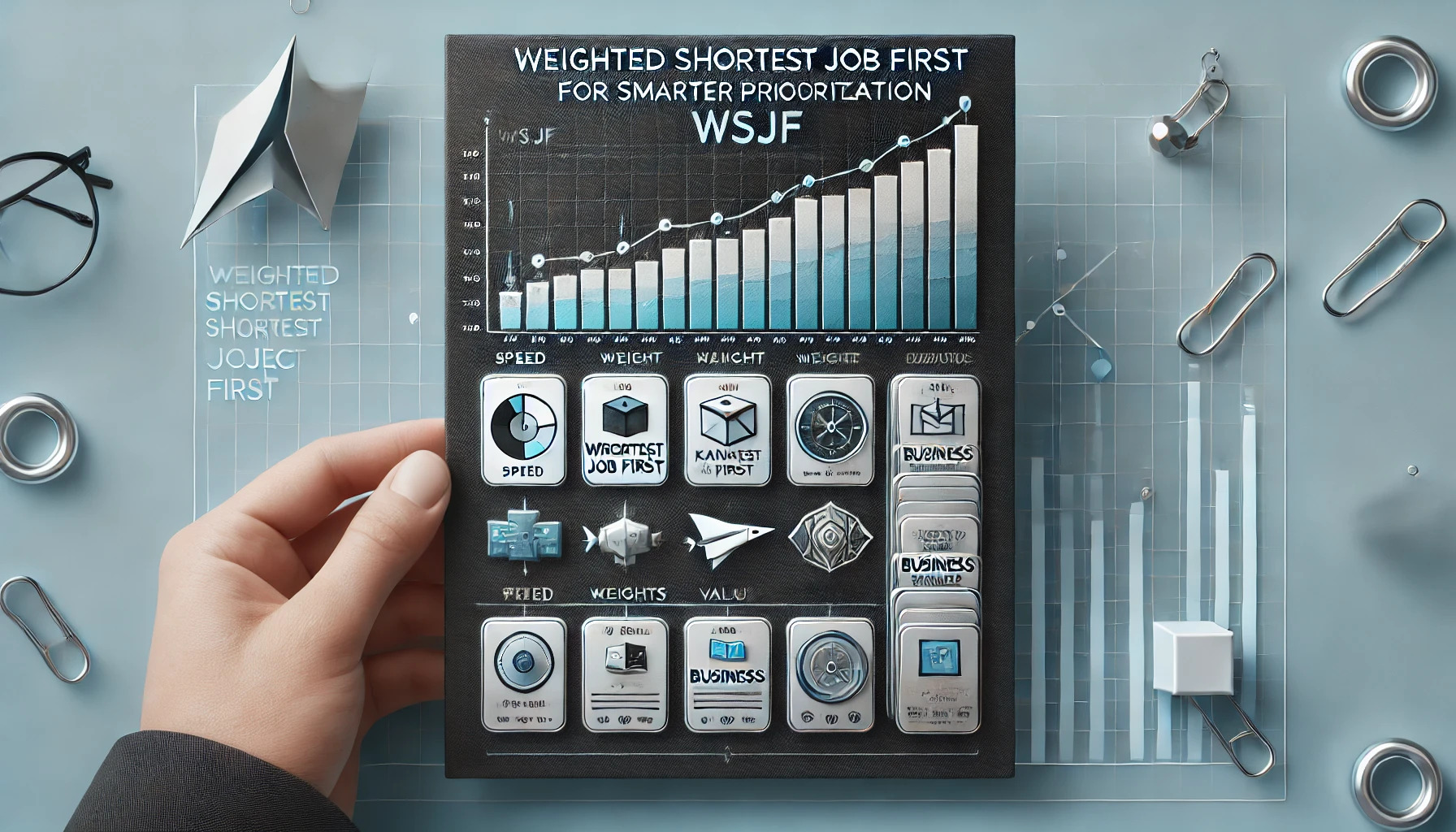If you’ve ever sat in backlog refinement thinking, “Which of these fifty items do we tackle first?”, you’re not alone. Agile teams constantly juggle new features, bug fixes, technical debt, and customer requests, and the struggle to prioritize is real.
As a Scrum Master or Agile Project Manager, you already know the pain: limited capacity, ambitious stakeholders, and competing deadlines. That’s where Weighted Shortest Job First (WSJF) swoops in like a friendly guide, helping you make choices without endless debates.
This isn’t about complex math or consulting-style charts. WSJF is simple, structured, and surprisingly fun once your team starts using it.
What Exactly Is WSJF?
Weighted Shortest Job First (WSJF) is a prioritization method designed to maximize value delivery in Agile and Lean systems. It’s core to the Scaled Agile Framework (SAFe), but you can apply it in any backlog context.
The big idea is simple: deliver the work with the highest value and lowest effort first.
Instead of giving in to whoever yells loudest in planning meetings, you get an objective, transparent way to rank backlog items.
The WSJF Formula
The beauty of WSJF lies in one small formula:
WSJF = Cost of Delay ÷ Job Size
Let’s unpack that.
- Cost of Delay (CoD): How much value you lose if you delay this item.
- Job Size: How big, complex, or time-consuming the work is.
The higher the score, the better the candidate for early delivery.
Breaking Down Cost of Delay
Cost of Delay is the heartbeat of WSJF. It typically has three parts:
- Business Value: What tangible benefits will customers or the business gain from this item?
- Time Criticality: Will delaying reduce the impact (think market windows, regulations, seasonal events)?
- Risk Reduction or Opportunity Enablement: Does this item open new doors or prevent future problems?
Your team assigns relative scores, usually in Fibonacci numbers (1, 2, 3, 5, 8, 13 …), to each factor.
Add them together, and you have the total Cost of Delay.
Example: Product Backlog Items
Imagine you’re working with your product owner on three backlog items:
- Enable PayPal Payments
- Improve Search Algorithm
- Build Recommendation Engine
Here’s how your team might score them:
| Item | Business Value | Time Criticality | Risk Reduction | CoD | Job Size | WSJF |
|---|---|---|---|---|---|---|
| PayPal Payments | 15 | 3 | 2 | 20 | 5 | 4 |
| Search Improvement | 20 | 7 | 3 | 30 | 15 | 2 |
| Recommendation Engine | 30 | 15 | 5 | 50 | 40 | 1.25 |
WSJF says PayPal comes first, even though the recommendation engine looks impressive. That’s because PayPal delivers value quickly without overwhelming effort.
This is the magic: WSJF stops your team from being distracted by the “big shiny thing” and helps you focus on what delivers value fastest.
Why WSJF Belongs in Every Scrum Master’s Toolkit
- It removes endless arguments. Numbers make prioritization conversations less emotional and more evidence-driven.
- It boosts stakeholder trust. Everyone sees the logic behind the order, not just opinions.
- It maximizes velocity impact. Teams deliver items with faster return on investment.
- It keeps work flowing. By emphasizing smaller, valuable items, the backlog moves forward steadily.
Instead of sticky note wars in sprint planning, you’ll have alignment and smiles.
WSJF in Backlog Refinement
Picture your team during refinement. The backlog has dozens of items, from small bug fixes to large epics. Without WSJF, you risk overcommitting to giant features that stall momentum.
With WSJF:
- Break down epics into smaller stories so job size is clear.
- Score each backlog item with the product owner and team.
- Rank them using the WSJF formula.
Suddenly, the sprint backlog fills with items that deliver value quickly, while still respecting strategic goals.
Portfolio-Level Prioritization
WSJF isn’t just for user stories or features—it scales beautifully to portfolios.
Imagine your organization has multiple initiatives:
- Expanding into a new region.
- Upgrading the platform for compliance.
- Building a new mobile app.
By applying WSJF, leadership sees which initiatives bring the greatest return for the least investment. It makes those quarterly planning sessions less about politics and more about results.
A Sprint Planning Story
Here’s a scenario you might recognize.
Your team has capacity for 30 story points this sprint. Three features are under consideration:
- Feature A: Customer dashboard. CoD = 25, Job Size = 10 → WSJF = 2.5
- Feature B: API integration. CoD = 15, Job Size = 5 → WSJF = 3
- Feature C: Performance optimization. CoD = 30, Job Size = 20 → WSJF = 1.5
Which features should make the sprint? WSJF shows that Feature B delivers the most value per effort. You then add Feature A, and if time allows, parts of Feature C.
This is how WSJF translates into real sprint choices. It ensures your team uses limited capacity wisely.
When WSJF Shines
WSJF works best when:
- You have too many items and too little capacity.
- Deadlines and market windows matter.
- Teams struggle with subjective prioritization debates.
- You want transparent, repeatable prioritization methods.
Scrum Masters love it because it balances conversation with structure. It respects Agile values while adding clarity.
When WSJF Isn’t Enough
Of course, WSJF isn’t a magic wand.
- Subjectivity creeps in. Different people may score differently, and bias can distort outcomes.
- Numbers get gamed. Stakeholders sometimes inflate scores to push pet projects.
- Not everything is comparable. Some initiatives are too strategic for WSJF alone.
The fix? Use WSJF as a guide, not gospel. Combine it with strategy, vision, and product goals.
WSJF vs. Other Prioritization Methods
You might wonder why not use MoSCoW, RICE, or even just HiPPO (Highest Paid Person’s Opinion).
- MoSCoW (Must, Should, Could, Won’t): Simple categories but lacks nuance.
- RICE (Reach, Impact, Confidence, Effort): Data-driven but often heavier than teams need.
- HiPPO: Quick but risky—decisions rely on power, not value.
WSJF balances simplicity with enough structure to make better decisions quickly. That’s why it’s a favorite in SAFe environments.
Making WSJF Engaging for Teams
Here’s how you can run a fun WSJF workshop with your Agile team:
- Collect backlog items as sticky notes or cards.
- Write CoD and Job Size factors on the board.
- Let team members score items collaboratively.
- Use Fibonacci numbers for relative sizing.
- Rank and discuss the final WSJF scores.
It turns prioritization into a team game, and everyone feels heard in the process.
Real-World Case: A Fintech Startup
A fintech team faced pressure to launch several features:
- Feature 1: Add Apple Pay.
- Feature 2: Upgrade security compliance.
- Feature 3: Build an investment dashboard.
Scoring revealed:
- Apple Pay: CoD = 40, Job Size = 10 → 4
- Security Upgrade: CoD = 30, Job Size = 15 → 2
- Dashboard: CoD = 50, Job Size = 40 → 1.25
The team delivered Apple Pay first, instantly pleasing customers and boosting adoption, while the dashboard waited until later.
WSJF turned their heated prioritization debate into a clear, data-driven decision.
Practical Steps for Agile Project Managers
You can start applying WSJF tomorrow by following these steps:
- List your backlog items. Use Jira, Trello, or a whiteboard.
- Score CoD factors. Involve business and tech perspectives.
- Estimate job size. Use story points or relative sizing.
- Calculate WSJF. Divide CoD by job size.
- Rank and plan. Use the highest scores for upcoming sprints or releases.
You don’t need perfection. The conversation and transparency matter more than the math.
Tips to Succeed with WSJF
- Facilitate fairly. As Scrum Master, ensure all voices are heard in scoring.
- Revisit often. Priorities change, so refresh scores regularly.
- Visualize clearly. Use tables, charts, or wall boards for impact.
- Balance with strategy. WSJF helps with execution but should align with product vision.
Final Thoughts
As an Agile Project Manager or Scrum Master, you’re always balancing limited capacity, competing demands, and impatient stakeholders. Weighted Shortest Job First helps you cut through the chaos with structure and fairness.
It keeps your team focused on delivering maximum value with minimum effort, sprint after sprint.
Think of WSJF not as a rigid formula, but as a compass. It points you toward the highest-impact work, while keeping conversations grounded in evidence rather than opinion.
Next time your backlog feels overwhelming, grab your markers, gather your team, and let WSJF decide. Your product owner, stakeholders, and customers will thank you.
How To Land the Job and Interview for Project Managers Course:
Advance your project management career with HK School of Management’s expert-led course. Gain standout resume strategies, master interviews, and confidently launch your first 90 days. With real-world insights, AI-powered tools, and interactive exercises, you’ll navigate hiring, salary negotiation, and career growth like a pro. Enroll now and take control of your future!
Coupons
Coupon code: BFFCDF2824B03205F986
Details: Custom price: $12.99
Starts 11/22/2025 12:50 PM PST (GMT -8)
Expires 12/23/2025 12:50 PM PST (GMT -8)
Agile Project Management and Scrum With AI – GPT
Coupon code: D15FD35B35A91EEFD12C
Details: Custom price: $12.99
Starts 11/22/2025 12:48 PM PST (GMT -8)
Expires 12/23/2025 12:48 PM PST (GMT -8)
Leadership for Project Managers: Leading People and Projects
Coupon code: 2D8DCCC495C113375046
Details: Custom price: $12.99
Starts 11/22/2025 12:48 PM PST (GMT -8)
Expires 12/23/2025 12:48 PM PST (GMT -8)
How To Land the Job and Interview for Project Managers
Coupon code: 0A7CD3D5BB9A3D2C9B60
Details: Custom price: $12.99
Starts 11/22/2025 12:53 PM PST (GMT -8)
Expires 12/23/2025 12:53 PM PST (GMT -8)
Coupon code: 17C5D2EDA4C670729592
Details: Custom price: $12.99
Starts 11/22/2025 12:48 PM PST (GMT -8)
Expires 12/23/2025 12:48 PM PST (GMT -8)




